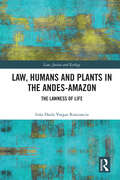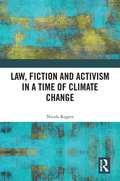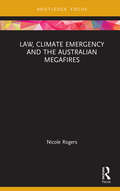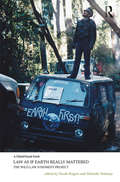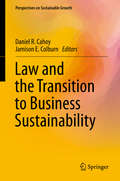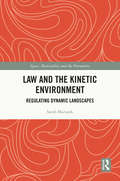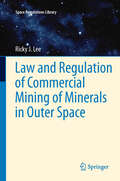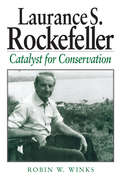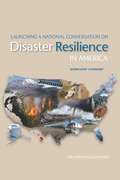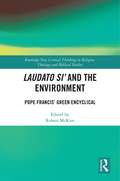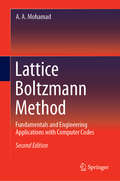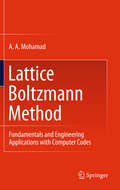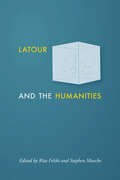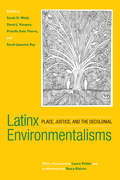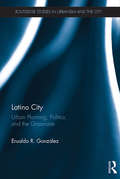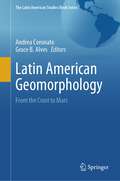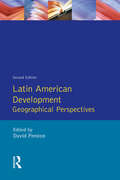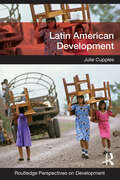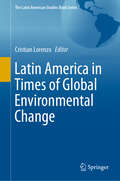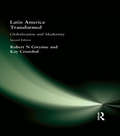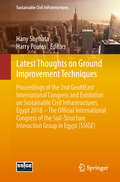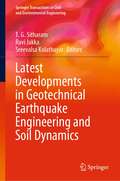- Table View
- List View
Law, Humans and Plants in the Andes-Amazon: The Lawness of Life (Law, Justice and Ecology)
by Iván Darío Vargas RoncancioExtending law beyond the human, the book examines the conceptual openings, methodological challenges, and ethical conundrums of law in a time of socio-ecological transition. How do we learn and practice law across epistemic and ontological difference? What sort of methodologies do we need? In what sense does conjuring other-than-human beings as sentient, cognitive and social agents—rather than mere recipients of state-sanctioned rights—transform what we mean by law and rights of nature in Latin America and beyond? Legal institutions exclusively focused on human perspectives seem insufficiently capable of addressing current socio-ecological challenges in Latin America and beyond. In response, this book strives to integrate other-than-human beings within legal thinking, institutions, and decision-making protocols. Weaving together various fields of knowledge and worldmaking practices that include – but are not limited to – Indigenous legal traditions, ecological law, multispecies ethnography, and ecological economics, the book pursues a multi-sited ethnography that focuses on the entanglement of law, ecology, and Indigenous cosmologies in Southern Colombia. In so doing, it articulates a general post-anthropocentric legal theory which is proposed, a tool to address socio-ecological challenges such as climate change and bio-cultural loss. This book will be of interest to scholars and students in the disciplines of environmental law, Earth law and ecological law, legal theory and critical legal studies; as well as others working in the in the fields of Indigenous studies, environmental humanities, legal anthropology, and sustainability and climate change justice.
Law, Fiction and Activism in a Time of Climate Change
by Nicole RogersThe book examines the narratives of climate change which have developed and which are currently evolving in three areas: law, fiction and activism. Narratives of climate change generated by litigants, judges, writers of fiction and activists are having, and will have, a profound effect on the way we respond to the climate change crisis. Acknowledging the prevalence of unreliable narrators, this book explores the reliability and significance of different forms of climate narrative. The author analyses overlapping themes and points of intersection, considering the recurrent motif of the trickster, the prominence of the child, the significance and ongoing viability of the rights discourse, and the increasingly prevalent emergency framing with its multiple implications for law’s empire. She asks how law, fiction and activism measure up as textual and performative fora for telling the story of climate change and anticipating a climate-changed future. And, in addition, how can they help foster transformative narratives which empower us to confront the climate change crisis? This highly topical, cross-disciplinary work will be of interest to anyone concerned about the growing climate emergency and makes a valuable contribution to climate law, environmental law, the environmental humanities and ecocriticism.
Law, Climate Emergency and the Australian Megafires
by Nicole RogersThis book addresses the ways in which the Black Summer megafires influenced the development of climate narratives throughout 2020. It analyses the global pandemic, and its ensuing restrictions, as a countervailing force in the production of such narratives. Lives and properties were lost in the spring and summer of 2019 and 2020, when catastrophic bushfires burnt through millions of hectares of mainland Australia. Nearly three billion native animals died. And for millions of Australians, and others worldwide, it was through the Australian megafires that the global climate emergency became tangible, concrete, no longer a comfortably deferred, albeit problematic abstraction which could be consigned to future generations to deal with. This book explores the legal and other implications of new understandings of climate emergency arising from the fires, and the emergence of a hierarchy of emergencies as the pandemic came to dominate global and domestic political discourses. It examines narratives of culpability, and legal avenues for seeking retribution from government and big fossil fuel emitters. It also considers the impact of the fires on the burgeoning phenomenon of climate activism, particularly in Australia, and the ways in which pandemic restrictions curtailed such activism. Finally, the book reflects on the fires through the lenses offered by climate fiction, and apocalyptic fiction more generally, in order to consider how these shape, and might shape, our responses to them. This important and timely book will appeal to environmental lawyers and socio-legal theorists; as well as other scholars and activists with interests in climate change and its impact. It is recommended for anyone concerned about current and future climate disasters, and the shortcomings in legal, political and popular responses to the climate crisis.
Law as if Earth Really Mattered: The Wild Law Judgment Project (Law, Justice and Ecology)
by Nicole Rogers Michelle MaloneyThis book is a collection of judgments drawn from the innovative Wild Law Judgment Project. In participating in the Wild Law Judgment Project, which was inspired by various feminist judgment projects, contributors have creatively reinterpreted judicial decisions from an Earth-centred point of view by rewriting existing judgments, or creating fictional judgments, as wild law. Authors have confronted the specific challenges of aligning existing Western legal systems with Thomas Berry’s philosophy of Earth jurisprudence through judgment writing and rewriting. This book thus opens up judicial decision-making and the common law to critical scrutiny from a wild law or Earth-centred perspective. Based upon ecocentric rather than human-centred or anthropocentric principles, Earth jurisprudence poses a unique critical challenge to the dominant anthropocentric or human-centred focus and orientation of the common law. The authors interrogate the anthropocentric and property rights assumptions embedded in existing common law by placing Earth and the greater community of life at the centre of their rewritten and hypothetical judgments. Covering areas as diverse as tort law, intellectual property law, criminal law, environmental law, administrative law, international law, native title law and constitutional law, this unique collection provides a valuable tool for practitioners and students who are interested in learning more about the emerging ecological jurisprudence movement. It helps us to see more clearly what a new system of law might look like: one in which Earth really matters.
Law and the Transition to Business Sustainability
by Daniel R. Cahoy Jamison E. ColburnThis book expands on law-related research by examining the legal aspects of sustainability with a focus on the impact on business strategies. It recognizes that firms must adopt an integrated approach to law and sustainability, considering multiple disciplines and goals, and serve as a forum for bringing together scholarship from fields such as environmental law, energy, government regulation and intellectual property. Firms increasingly have an interest in transitioning to sustainable business practices that take into consideration the fact that global resources are finite and will be increasingly scarce. They acknowledge that current actions have social, economic and environmental consequences and employ options to ensure that future generations have the same options and benefits. Examples of sustainable practices increasingly employed by firms include the institutionalization of "whole life-cycle" analysis in marketing and product design, utilization of sustainable inputs and energy sources, tracking and reporting sustainability performance, attempting the valuation of future generation prosperity and happiness as a discounting mechanism, and integrating sustainability into firm culture and management goals. It is clear that law and regulation have an extremely important role to play in the transition to more sustainable business practices. Broadly stated, law can provide structure for firms responding to forces that pull transition by enabling sustainability leadership and competitive advantage through funding models, intellectual property rights and collaboration means. Additionally, law can work to push transition by compelling firms to act through regulatory structures, accounting and governance mechanisms.
Law and the Kinetic Environment: Regulating Dynamic Landscapes (Space, Materiality And The Normative Ser.)
by Sarah MarusekThis book addresses the legal-geographical implications of the fact that landscapes are not static, but dynamic. Within the field of legal geography, the spatial relationship of law to landscape is usually considered to be static. Environments are often considered fixed, and consequently inert, as places that literally don’t go anywhere. Typically, then, it is what happens in these places, rather than the place itself, that commands academic attention. In contrast to this static viewpoint, Law and the Kinetic Environment considers how many landscapes are in flux and, as a result, may be seen as dynamic. Natural phenomena, such as oozing lava, moving glaciers, or bubbling geothermal pools, challenge and test the normative conceptualizations of stability of place, property ownership, and legal regulation. Consequently, such dynamic landscapes enliven and transform law, offering new jurisprudential insights into what law is and how it operates in response to the kineticism that, this book argues is, to some degree, inherent in all landscapes. This original engagement with legal geography will appeal to those with general interests in this area, as well as specific concerns with questions of law and place, property and the environment.
Law and Regulation of Commercial Mining of Minerals in Outer Space
by Ricky LeeThis monograph addresses the legal and policy issues relating to the commercial exploitation of natural resources in outer space. It begins by establishing the economic necessity and technical feasibility of space mining today, an estimate of the financial commitments required, followed by a risk analysis of a commercial mining venture in space, identifying the economic and legal risks. This leads to the recognition that the legal risks must be minimised to enable such projects to be financed. This is followed by a discussion of the principles of international space law, particularly dealing with state responsibility and international liability, as well as some of the issues arising from space mining activities. Much detail is devoted to the analysis of the content of the common heritage of mankind doctrine. The monograph then attempts to balance such interests in creating a legal and policy compromise to create a new regulatory regime.
Laurance S. Rockefeller: Catalyst For Conservation
by Robin W. Winks Bruce BabbittDespite his status as a scion of one of the wealthiest and most famous families in the United States and an enormously successful businessman in his own right, Laurance S. Rockefeller is unknown to all but a few Americans. Yet while he has been neither Vice President nor Governor nor chairman of the world's largest bank, his contribution to society has been at least as great as that of his more famous brothers. In Laurance S. Rockefeller: Catalyst for Conservation, noted historian Robin W. Winks brings Laurance to the forefront, offering an intimate look at his life and accomplishments. While Rockefeller has played a vital role in the business world as one of the most astute venture capitalists of our time--providing seed money for, among other endeavors, Eastern Airlines, Intel Corporation, and Apple Computers--his driving passion throughout his life has been the environment In addition to donating millions of dollars and the helping to found numerous conservation organizations, he served under five consecutive presidents in environmental advisory capacities. As chairman of the Outdoor Recreation Resources Review Commission (ORRRC) under Presidents Eisenhower and Kennedy, Rockefeller orchestrated an assessment of the recreation and conservation needs of the American people and the policies and programs required to meet those needs. The reports issued by the Commission are a groundbreaking achievement that laid the framework for nearly all significant environmental legislation of the following three decades. Winks uses a combination of historical insight and extensive research to present the first in-depth examination of Laurance Rockefeller's life and work. His book explores Rockefeller's role in the transition from traditional land conservation to a more inclusive environmentalism. It compels broader interpretation of the history of environmental protection, and is essential reading for anyone concerned with the past or future of conservation in America.
Launching a National Conversation on Disaster Resilience in America
by The National Academies Committee on Science, Engineering, and Public Policy Committee on Increasing National Resilience to Hazards and Disasters Peggy TsaiWith the increasing frequency of natural and human-induced disasters and the increasing magnitude of their consequences, a clear need exists for governments and communities to become more resilient. The National Research Council's 2012 report Disaster Resilience: A National Imperative addressed the importance of resilience, discussed different challenges and approaches for building resilience, and outlined steps for implementing resilience efforts in communities and within government. Launching a National Conversation on Disaster Resilience in America is a summary of a one-day event in November 2012 to formally launch a national conversation on resilience. Nationally-recognized experts in disaster resilience met to discuss developing a culture of resilience, implementing resilience, and understanding federal perspectives about resilience. This report includes a broad range of perspectives and experiences derived from many types of hazards and disasters in all parts of the country.
Laudato Si’ and the Environment: Pope Francis’ Green Encyclical (Routledge New Critical Thinking in Religion, Theology and Biblical Studies)
by Robert McKimThis volume is a response to the Pope’s Laudato Si’, giving an interdisciplinary overview of its impact on the environmental concerns of Catholics as well as other religious groups. Published in 2015, it is often seen as an "environmental" encyclical and in it the Pope urges us to face up to the crisis of climate change. He argues that all of us should prioritise taking better care of the Earth, our common home, while also attending to the plight of the poor. Written by an international and multidisciplinary team of leading scholars, the Pope’s invitation to all people to begin a new dialog about these matters is considered from a variety of perspectives. There is discussion of the implications for immigration, population control, eating animals, and property ownership. Additionally, indigenous religious perspectives, development and environmental protection, and the implementation of the ideas of the encyclical in the Church are explored. Each chapter deals with the scriptural, theological, and philosophical underpinnings of the encyclical, as well as other central concepts such as interconnectedness, the role of practice, and what Pope Francis calls the "technocratic paradigm". This book expertly illuminates the relationship between Laudato Si’ and environmental concerns. It will, therefore, be vital reading for anyone studying religion and the environment, environmental ethics, Catholic theology, and environmental thought.
Lattice Models for Fluctuating Hydrodynamics in Granular and Active Matter (Springer Theses)
by Alessandro ManacordaThis book investigates the common nature of granular and active systems, which is rooted in their intrinsic out-of-equilibrium behavior, with the aim of finding minimal models able to reproduce and predict the complex collective behavior observed in experiments and simulations. Granular and active matter are among the most studied systems in out-of-equilibrium statistical physics. The book guides readers through the derivation of a fluctuating hydrodynamic description of granular and active matter by means of controlled and transparent mathematical assumptions made on a lattice model. It also shows how a macroscopic description can be provided from microscopic requirements, leading to the prediction of collective states such as cooling, swarming, clustering and the transitions among them. The analytical and numerical results shed new light on the physical connection between the local, microscopic properties of few particles and the macroscopic collective motion of the whole system.
Lattice Boltzmann Method: Fundamentals and Engineering Applications with Computer Codes
by A. A. MohamadThis book introduces readers to the lattice Boltzmann method (LBM) for solving transport phenomena – flow, heat and mass transfer – in a systematic way. Providing explanatory computer codes throughout the book, the author guides readers through many practical examples, such as:• flow in isothermal and non-isothermal lid-driven cavities;• flow over obstacles;• forced flow through a heated channel;• conjugate forced convection; and• natural convection.Diffusion and advection–diffusion equations are discussed, together with applications and examples, and complete computer codes accompany the sections on single and multi-relaxation-time methods. The codes are written in MatLab. However, the codes are written in a way that can be easily converted to other languages, such as FORTRANm Python, Julia, etc. The codes can also be extended with little effort to multi-phase and multi-physics, provided the physics of the respective problem are known.The second edition of this book adds new chapters, and includes new theory and applications. It discusses a wealth of practical examples, and explains LBM in connection with various engineering topics, especially the transport of mass, momentum, energy and molecular species.This book offers a useful and easy-to-follow guide for readers with some prior experience with advanced mathematics and physics, and will be of interest to all researchers and other readers who wish to learn how to apply LBM to engineering and industrial problems. It can also be used as a textbook for advanced undergraduate or graduate courses on computational transport phenomena
Lattice Boltzmann Method
by A. A. MohamadLattice Boltzmann Method introduces the lattice Boltzmann method (LBM) for solving transport phenomena - flow, heat and mass transfer - in a systematic way. Providing explanatory computer codes throughout the book, the author guides readers through many practical examples, such as: flow in isothermal and non-isothermal lid driven cavities;flow over obstacles;forced flow through a heated channel;conjugate forced convection; andnatural convection.Diffusion and advection-diffusion equations are discussed with applications and examples, and complete computer codes accompany the coverage of single and multi-relaxation-time methods. Although the codes are written in FORTRAN, they can be easily translated to other languages, such as C++. The codes can also be extended with little effort to multi-phase and multi-physics, if the reader knows the physics of the problem. Readers with some experience of advanced mathematics and physics will find Lattice Boltzmann Method a useful and easy-to-follow text. It has been written for those who are interested in learning and applying the LBM to engineering and industrial problems and it can also serve as a textbook for advanced undergraduate or graduate students who are studying computational transport phenomena.
Latour and the Humanities
by Rita Felski and Stephen MueckeHow does the work of influential theorist Bruno Latour offer a fresh angle on the practices and purposes of the humanities?In recent years, defenses of the humanities have tended to argue along predictable lines: the humanities foster empathy, the humanities encourage critical thinking, the humanities offer a counterweight to the cold calculations of the natural and social sciences. The essays in Latour and the Humanities take a different approach. Exploring the relevance of theorist Bruno Latour's work, they argue for attachments and entanglements between the humanities and the sciences while looking closely at the interests, institutions, and intellectual projects that shape the humanities within and beyond the university. The collection, which is written by a group of highly distinguished scholars from around the world, is divided into two sections. In the first part, authors engage in depth with Latour's work while also rethinking the ties between the humanities and the sciences. Essays argue for greater attention to the nonhuman world, the urgency of climate change, and more nuanced views of universities as institutions. The second half of the volume contains essays that reflect on Latour's influence on the practices of specific disciplines, including art, the digital humanities, film studies, and political theory.Inspiring conversation about the relevance of actor-network-theory for research and teaching in the humanities, Latour and the Humanities offers a substantial introduction to Latour's work while discussing the humanities without falling back on the genres of either the sermon or the jeremiad. This volume will be of interest to all those searching for fresh perspectives on the value and importance of humanistic disciplines and thought.Contributors: David J. Alworth, Anders Blok, Claudia Breger, Dipesh Chakrabarty, Yves Citton, Steven Connor, Gerard de Vries, Simon During, Rita Felski, Francis Halsall, Graham Harman, Antoine Hennion, Casper Bruun Jensen, Bruno Latour, Heather Love, Patrice Maniglier, Stephen Muecke, Barbara Herrnstein Smith, Nigel Thrift, Michael Witmore
Latinx Environmentalisms: Place, Justice, and the Decolonial
by Stacy AlaimoThe whiteness of mainstream environmentalism often fails to account for the richness and variety of Latinx environmental thought. Building on insights of environmental justice scholarship as well as critical race and ethnic studies, the editors and contributors to Latinx Environmentalisms map the ways Latinx cultural texts integrate environmental concerns with questions of social and political justice. Original interviews with creative writers, including Cherríe Moraga, Helena María Viramontes, and Héctor Tobar, as well as new essays by noted scholars of Latinx literature and culture, show how Latinx authors and cultural producers express environmental concerns in their work. These chapters, which focus on film, visual art, and literature—and engage in fields such as disability studies, animal studies, and queer studies—emphasize the role of racial capitalism in shaping human relationships to the more-than-human world and reveal a vibrant tradition of Latinx decolonial environmentalism. Latinx Environmentalisms accounts for the ways Latinx cultures are environmental, but often do not assume the mantle of “environmentalism.”
Latino City: Urban Planning, Politics, and the Grassroots (Routledge Studies in Urbanism and the City)
by Erualdo R. GonzalezAmerican cities are increasingly turning to revitalization strategies that embrace the ideas of new urbanism and the so-called creative class in an attempt to boost economic growth and prosperity to downtown areas. These efforts stir controversy over residential and commercial gentrification of working class, ethnic areas. Spanning forty years, Latino City provides an in-depth case study of the new urbanism, creative class, and transit-oriented models of planning and their implementation in Santa Ana, California, one of the United States’ most Mexican communities. It provides an intimate analysis of how revitalization plans re-imagine and alienate a place, and how community-based participation approaches address the needs and aspirations of lower-income Latino urban areas undergoing revitalization. The book provides a critical introduction to the main theoretical debates and key thinkers related to the new urbanism, transit-oriented, and creative class models of urban revitalization. It is the first book to examine contemporary models of choice for revitalization of US cities from the point of view of a Latina/o-majority central city, and thus initiates new lines of analysis and critique of models for Latino inner city neighborhood and downtown revitalization in the current period of socio-economic and cultural change. Latino City will appeal to students and scholars in urban planning, urban studies, urban history, urban policy, neighborhood and community development, central city development, urban politics, urban sociology, geography, and ethnic/Latino Studies, as well as practitioners, community organizations, and grassroots leaders immersed in these fields.
Latin American Society
by Tessa CubittFirst published in 1995. Routledge is an imprint of Taylor & Francis, an informa company.
Latin American Geomorphology: From the Crust to Mars (The Latin American Studies Book Series)
by Andrea Coronato Grace B. AlvesThis book presents varied geomorphological topics and planetary studies from different geomorphological regions analysed by young researchers from Latin America, from Costa Rica to southern Argentina, from the mountains to the oceans, and from the Caribbean to the Scotia tectonic plates. The six chapters included in this book originate from presentations made during the “IAG Central and South American Webinar” carried on in March 2021 for the commemoration of the “Geomorphology Week”, promoted by the International Association of Geomorphologists (IAG) and coordinated by the invited book editors. The chapters develop topics related to landforms and geomorphological processes originated by modern tectonics along a transform tectonic plate boundary, by cryo-snowy environments in the drier Central Andes, by fluvial and littoral processes in the Brazilian inland and the Atlantic coast, and by high runoff generated by storm-cells driving into mountainousand wooded terrains. New insights on Mars water features research are also included in the book. Several chapters refer to risk assessment for society or resource management considerations; other chapters refer to present or recent geomorphological processes but others do so to those developed in the Quaternary.
Latin American Development: Geographical Perspectives
by David A. PrestonProvides an up-to-date analysis of many aspects of Latin America through a series of short essays, written by experienced geographers.
Latin American Development (Routledge Perspectives on Development)
by Julie CupplesLatin America’s diverse political and economic struggles and triumphs have captured the global imagination. The region has been a site of brutal dictators, revolutionary heroes, the Cold War struggle and as a place in which the global debt crisis has had some of its most lasting and devastating impacts. Latin America continues to undergo rapid transformation, demonstrating both inspirational change and frustrating continuities. This text provides a comprehensive introduction to Latin American development in the twenty-first century, emphasizing political, economic, social, cultural and environmental dimensions of development. It considers key challenges facing the region and the diverse ways in which its people are responding, as well as providing analysis of the ways in which such challenges and responses can be theorized. This book also explores the region’s historical trajectory, the implementation and rejection of the neoliberal model and the role played by diverse social movements. Relations of gender, class and race are considered, as well as the ways in which media and popular culture are forging new global imaginaries of the continent. The text also considers the increasing difficulties that Latin America faces in confronting climate change and environmental degradation. This accessible text gives an overarching historical and geographical analysis of the region and critical analysis of recent developments. It is accompanied by a diverse range of critical historical and contemporary case studies from all parts of the continent, providing readers with the conceptual tools required to analyse theories on Latin American development. Each chapter ends with a summary section, discussion topics, suggestions for further reading, websites and media resources. This is an indispensable resource for scholars, students and practitioners.
Latin America in Times of Global Environmental Change (The Latin American Studies Book Series)
by Cristian LorenzoThis volume discusses the challenges of Latin America in global environmental geopolitics. Written by leading experts, this book brings together Latin American research on global environmental change. They cover a range of topics such as climate change, water, forest and biodiversity conservation connected with science policies, public opinion, priorities of international funds, and international politics of Latin American countries. The book describes the discrepancy between the international priorities and the regional needs or country interests. It includes several case studies and analyses the cooperation in multilateral negotiations on climate change. It also offers a synthesis of debates around global environmental changes and Latin American politics, which the authors have previously promoted in different academic events in South America, including in Santiago de Chile in Chile, and Buenos Aires and Ushuaia in Argentina.This book assesses the environmental problems from different perspectives, highlights the scientific development in the environmental changes affecting Latin America and offers a new view on geopolitics to help face those issues. Specialist readers in international relations, political sciences, environmental sciences, geography and geopolitics will appreciate this up-to-date examination of Latin America and the global environmental change.
Latin America Transformed: Globalization and Modernity
by Robert N Gwynne Kay CristobalPraise for the first edition:'Accomplishes its task to provide readers with a broad multi-disciplinary view on globalization's many impacts on Latin America ... the organization of the collection is logical and thoughtful, and the structural perspectives offered are convincing and powerful. I recommend it to other Latin American social scientists.' Growth and Change 'An impressive, timely and lively volume, which is especially valuable for teaching purposes.' Journal of Latin American Studies'Authoritatively written by leading scholars in their respective fields.' AreaLatin America Transformed, 2nd Edition explains the region's economic, political, social and cultural transformations, its association with globalization and the search for modernity, and contributes to a greater understanding of how these transformations are affecting the people of Latin America.Using a political economy approach to unravel the concepts of globalization and modernity within Latin America, emphasis is placed on interpreting the macro-level structures that frame the transformations taking place. The book also investigates the dynamics of people's livelihoods as they make sense of, rework and live out these structural transformations. The international team of authors involved with the successful first edition have updated their focus and substantially rewritten their material to examine the challenges facing Latin America in the twenty-first century. Three completely new chapters have also been added. Latin America Transformed, 2nd Edition is now even more useful for undergraduate and postgraduate courses that examine economic, political, social and cultural change in Latin America.
Latest Thoughts on Ground Improvement Techniques: Proceedings of the 2nd GeoMEast International Congress and Exhibition on Sustainable Civil Infrastructures, Egypt 2018 – The Official International Congress of the Soil-Structure Interaction Group in Egypt (SSIGE) (Sustainable Civil Infrastructures)
by Hany Shehata Harry PoulosThe volume contains research studies that cover a wide range of topics related to ground improvement and subsurface structures. This selection of papers represents the state-of-the-art in the analysis and design of different techniques of the ground improvement and deep mixing techniques. It provides engineers and researchers with an update on the recent development in ground improvement techniques and on the analysis and design of important soil structures problems. The volume is based on the best contributions to the 2nd GeoMEast International Congress and Exhibition on Sustainable Civil Infrastructures, Egypt 2018 – The official international congress of the Soil-Structure Interaction Group in Egypt (SSIGE).
Latest Ordovician to Early Silurian Shale Gas Strata of the Yangtze Region, China
by Xu Chen Daniel Goldman Hongyan WangThis book presents the accumulated data and current state of geological knowledge on China’s main shale gas fields. It addresses a broad range of topics, including the geological setting, reference sections and published boreholes, lithostratigraphy, biostratigraphy and chronostratigraphy, sedimentology and sequence stratigraphy of the late Ordovician to early Silurian, spatial and temporal distribution patterns and environmental changes in the black shales of the Wufeng and Lungmachi formations, numerical analysis of the Wufengian and Lungmachian Total Organic Carbon (TOC), late Ordovician to early Silurian bentonites of the Yangtze region, and a graptolite atlas of the Wufeng and Lungmachi formations. Given its scope, the book represents a valuable asset for researchers and petroleum engineers alike.
Latest Developments in Geotechnical Earthquake Engineering and Soil Dynamics (Springer Transactions in Civil and Environmental Engineering)
by T. G. Sitharam Sreevalsa Kolathayar Ravi JakkaThis volume brings together contributions from world renowned researchers and practitioners in the field of geotechnical engineering. The chapters of this book are based on the keynote and invited lectures delivered at the 7th International Conference on Recent Advances in Geotechnical Earthquake Engineering and Soil Dynamics. The book presents advances in the field of soil dynamics and geotechnical earthquake engineering. A strong emphasis is placed on proving connections between academic research and field practice, with many examples, case studies, best practices, and discussions on performance-based design. This volume will be of interest to research scholars, academicians and industry professionals alike.
